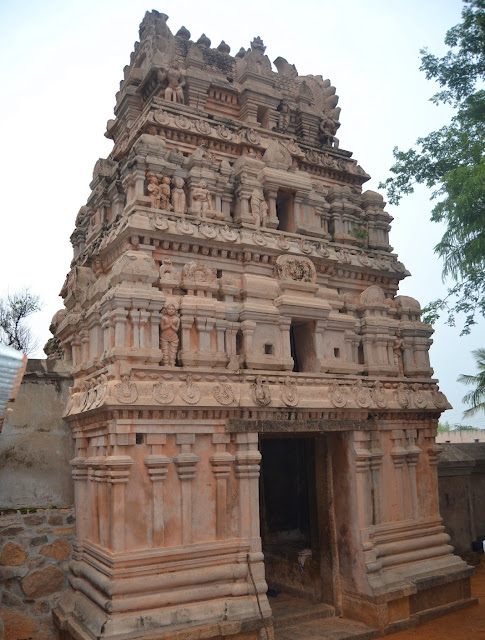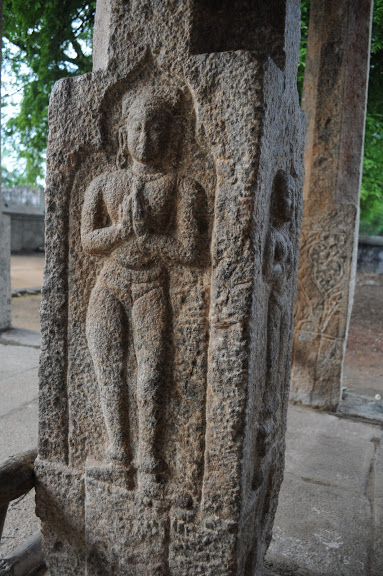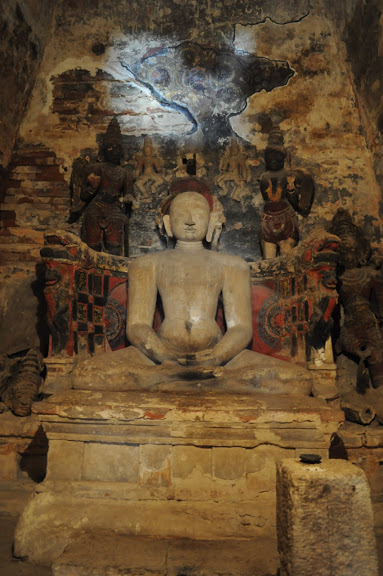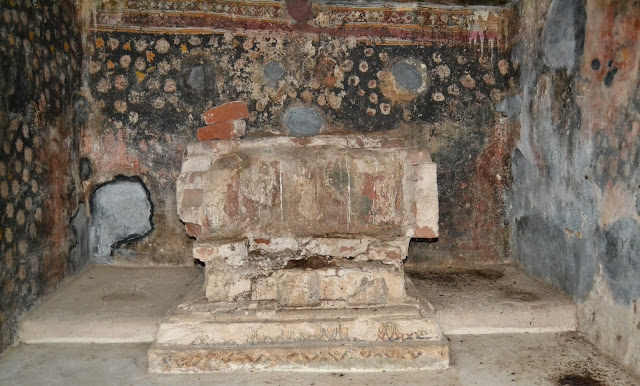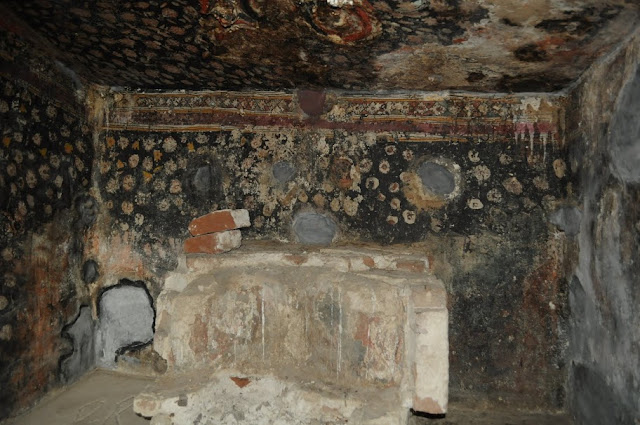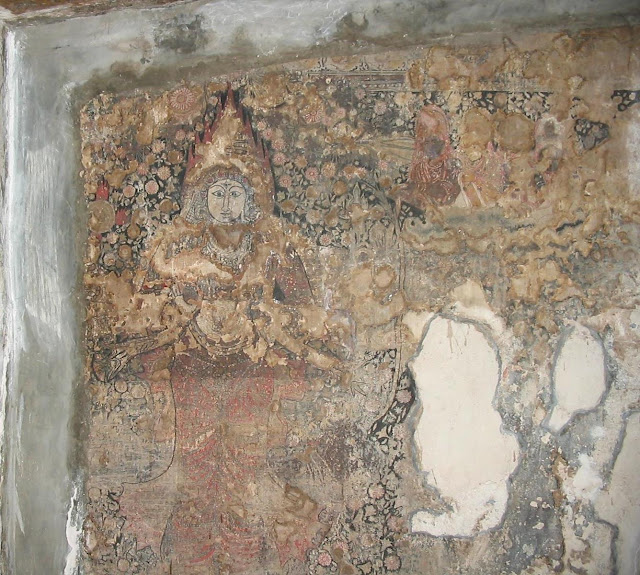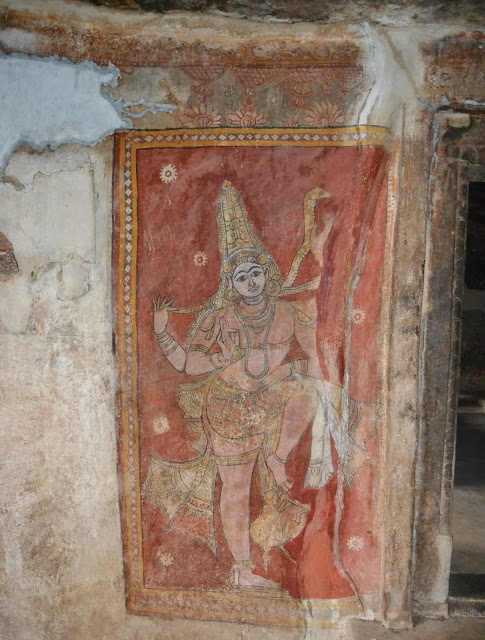Tirumalai Jain Complex, Arani, Thiruvannamalai
Tirumalai Jain
Complex is a Jain temple and cave complex dating from at least the 9th
century that is located northwest of Polur in Tamilnadu. The complex includes 3 Jain caves, 3 Jain
temples, and a 16 meter high
sculpture of Thirthankar Neminathar thought to date from the 12th century
that is the tallest Jain image in Tamilnadu. Since 7th Century AD Jains has been living
this village. Anciently this place was called as Vaigavur & Srisailapuram
and the hill area is Tirumalai.
Tirumalai
is a small village and an important historical place for Jains. It is situated at
about 4 Kms from Vadamathimangalam (a spot in Arani – Polur Road). Thirumalai
Jain Complex is under the control of Archeology survey of India. A Jain
Math called Arahanthgiri Jain Math was established near Tirumalai in August, 1998. The Math is headed by Bhattaraka Dhavalakeerthi.
Jain Complex
Mahavira Temple:
At the
foot of the Thirumalai hill, there is separate sannidhi for Mahaveera.
This seems to have been built during Vijayanagara period in the 16th century. This
Temple was built to the west of the Kunthavai Jinalaya. There are
paintings at the back of the main deity – which probably belongs to
Vijayanagara period – possibly later.
The
Temple has a three tier Rajagopuram and surrounded by walls on all sides. It
has a Panchaparameshti shrine near the entrance. A well called as Moondradi Kinaru,
was used by the nearby people in ancient times. The story of Shri Dharmadevi
indicate that she had been used the well for feeding her children on her previous
life.
Next,
the complex has Shri Mahaveerar Jinalaya with Garbhagriha, Arthamandapam,
Mahamandapam (with steps to reach) and Mugamandapam on the floor level. The
sanctum has lime mortar idol of Shri Mahaveerar about 4 feet high on the
plinth. Art of fresco paintings are located on the back of the idol.
It was
crowned by three stage vimana, consists of twenty four Thirthankar idols
without lanchan on four directions. Apart from, a granite carving of Shri
Mahaveera with eight features placed in the Arthamandapam porch. Two
inscriptions of King Rajaraja Chola and King Rajendra Chola period are also
found on this Temple.
Caves:
Jain
Caves are located little above in the Thirumalai Hills. It is the most interesting
place in this Jain Complex. The caves are with unique fresco paintings. It is
amazing place with breathtaking paintings. The paintings on the walls were
supposed to be from Vijayanagara period. The ones on the ceiling are from Chola
period.
It
consists of three or four compartments. The outer side of the cave is about 6 –
7 feet high but inner side it’s about a foot. The large cavern at the base of
the site is thought to have been built around the 9th century. In
the 10th century it was converted into 30 separate chambers, possibly to
accommodate figures of Thirthankars and a Yakshi.
The
entire ceiling was painted with beautiful pattern, which when lying on the
floor and looking up gives the feeling of a carpet above us. The patterns are
fantastic and the colour combination depicts the artist vision. The smaller
compartment also sports beautiful paintings on the ceiling.
It is
interesting to note that they have taken effort to paint even where ceiling is
no more than two feet high. Paintings are thought to have been added to the
site between the 15th - 17th centuries. Some of these
still survive. Medical-pits are ditched there for treating the people by the
Jain monks.
Adjacent
to the paintings, just below there are carvings of Ambika Yakshi,
Gommateshwara, Parshwanath and Adhinathar all belong to Chola period. The place
is pretty narrow, photographing is difficult.
Neminathar Statue:
There is
an 18 feet tall Neminathar statue engraved on the hill located to the northern
side of the Caves just below the summit. Neminathar is also called as
Shikamaninathar and is facing south. It belongs to later Chola period. It is
enormous, simple and plain. There is no ornamentation, unlike the one at the
lower caves.
The
statue looks like the image of Shri Gommateshwara at Shravanabelagola,
Karnataka. It was made to commemorate the Emperor Rajaraja Chola Victory
against his nemesis by his sister Kunthavai Piratiyar. The protector goddess of
Shri Neminathar Thirthankar called as Shri Kooshmandini (Dharmadevi) freezes
with the hill.
On the
previous birth, she was abandoned by her husband with two daughters for
devoutness among Jain munis. After getting demise she became a Yakshi named as
Shri Kooshmandini, on her rebirth. But the previous birth husband wants to
resume his married life with her. Then she explained that she acquired the
state of Yakshi.
After
hearing the story, he was unconscious and demised. Suddenly he got rebirth as
lion and become a seat for the Yakshi. A beautiful carving of Shri Dharmadevi
on the rock influences the story. It belongs to 10th Century AD art. It is
located on the western side of the Thirumalai Hill.
The
steps are provided with hand rails to reach the top, which was made by the
donations given by Shrimathi Jayavathi ammal w/o Sathanna Chettiar, Kumbakonam
and Shri Bhoobala Upathiyayar, endowment board member, was known by two
inscriptions incised near the steps and adjacent to the hill-spring. There is a
carving statue of Shri Neminathar in a shrine and Shri Parswanathar mini
Jinalaya were present.
Kunthavai Jain Temple:
The Kunthavai
Jinalaya temple is a 10th century Jain
temple, said to have been
commissioned by queen Kunthavai. It is one of two such sites commissioned by her,
though the other site Dadapuram, has not survived. Shri Neminathar Jinalaya was built
by Shri Kunthavai Nachiyar, sister of Rajaraja Chola. It was adjacent to and
few feet above the Mahaveerar temple. It has few steps to reach.
The
Temple complex is surrounded by walls on all sides. A Chadhur mugi vimana-model
and altar are placed in the corridor. The 11th Century AD Jinalaya
consists of Gharbahriha, Anthralam, Arthamandapam, Maha Mandapam and Mugamandapam
porches. On top of sanctum has hexagonal basement structure, might be the
residuals of demolished vimana.
The
sanctum got Shri Neminathar idol on the plinth. Another idol of Shri
Neminathar, stone carving, with Mukkudai is seated on the porch. Bamboo leaves
etch on the back of the idol indicates the enlightenment-tree of Shri Neminathar
Jinar. It might be the first installed Moolavar idol because it belongs to 11th
Century AD.
Shri
Brahmadevar and Shri Jwalamalini idols were also established in the Jinalaya.
The front porch was built in 16th Century AD. On the southern
corridor of the temple a peetam is installed on a platform, to commemorate the Moksha
of Shrivatheebha simmar Muni. He attained moksha after taking fast up to demise
at Tirumalai hundred years back. He also dedicated a Jain sithantham named as
Kshetra Sinthamani.
Along
the northern side of temple, bas-relief sculptures are on the top surfaces of
the rock. Then it was closed by wall and made as shrines. There were staircases
to reach Shri Kooshmandini Shrine. Kooshmandini is of 4 feet high mounted on
lion and with two girls and a maid carved beautifully.
Bhagavan
Bahubali relief has bunch of hair on head and crawling vein over body. Two
sisters of Brahmi and Sundari carvings are on either side. Shri Adhinathar
bas-relief with Mukkudai over the head and Shamara maids are on either side in
the sitting posture.
Shri Parswanathar
Bhagavan relief is 4 feet high carving with five-headed snake on the back in
the standing posture. Kamadan, Shri Dharanendrar, and Shri Padmavathy are also
in the cluster. The bas-reliefs belongs to 10th Century AD.
Hill Top Jain Temple:
Atop the
hill, there is a small sannidhi for Shri Parswanathar. This Temple consists of
Sanctum, shikhara and Kalasha. The Thirthankar idols are seated in four
directions on the Vimana. A Stone plate carving of Shri Parshwanath, in
standing posture and a five headed snake is upon the head, was established
inside the Sanctum plinth.
Three
Jain monks have done called ‘vadakiruthual’ on top of this hill. There are
three sets of foot-prints of these monks on the peak of the Hill. On the west
is for Shri Virushabasenar, on east is for Shri Samanthapadra Ganadharabahavar
and on north is for Shri Varathatthachariar, engraved to commemorate the
saints. The looks of the plains and Vaigai Lake from here are breathtaking.
A rare
variety of Devaalari tree is present on the peak have a grand look. The hill
has many ‘temple trees’ which withers sweet smelling flowers regularly, giving
a serene atmosphere. There are few inscriptions near the padams, all
belonging to very late period. There is one inscription by ASI itself done in
the year 1932.
King Statue:
There
was Statue of the King below the hills adjacent to the road. Villagers believe
that the statue was Rajaraja, but it doesn’t look like Rajaraja. It clearly
belongs later period may be Vijayanagara or Nayak. It might belong to the local
chieftain.
Arahanthgiri Jain Math:
Arahanthgiri
Jain Math is a Jain
Math that established near Tirumalai in August, 1998. The Math is headed by Bhattaraka Dhavalakeerthi. It is an ancient Jain Math in Tamilnadu. This Jain
Math is also known as Shri Kshetra Arahanthgiri Digambar Jain Mandir. Tirumalai
popularly called as Arihanthagiri among the people is a Jain pilgrim centre
having a history of over 2,300 years. History of Arahanthgiri Jain Math
starts from the period of 322–185 BCE as the Last ‘Shrutakevali’ Bhadrabahu
expected to stay at this place. He stayed at this place to practice meditation
and “Swadhyaya” along with 8000 other saints.
The
Village Thirumalai where this Jain Math is located is also known as Arhatsugiri
or Arahanthgiri. Various schemes have been undertaken here with an
intension of propagating Jainism. The most important among them is the Acharya
Akalanka Vidyapeetha Gurukula. The complex is now managed by Archaeological
Survey of India.
Inscriptions:
An
inscription found on a buried rock in front of the gopuram at the base of the
hill from the late 10th century refers to the site as Vaigai-Malai
or “the mountain of Vaigai.” Two other inscriptions found on a piece of rock at
the top of the hill and buried on a piece of rock underneath the steps between
the gopuram and the painted cave refer to it as Vaigai-Tirumalai or “the holy
mountain of Vaigai.” The name Vaigai is thus thought to be connected with
Vaigavur, the historic name of the village at the base of the rock.
Poojas
Daily
Pooja is run by the assistance given by Arahanthgiri Jain Math. Also a special
Pooja and ritual has been celebrated in the Tamil month of Thai. The nearby
people of Tirumalai of all sects are attending the function every year
regularly.
Connectivity
This
place can be reached via Arani, the nearest town. This place is located on the
Arani to Polur, Thiruvannamalai Road. The place is located at about 25 Kms from
Chetpet, 20 Kms from Arani, 48 Kms from Thiruvannamalai and 55 Kms from
Vandavasi. Nearest Railway Station is located at Arani and Nearest Airport is
located at Pondicherry and Chennai.




















